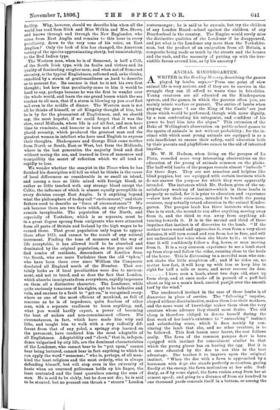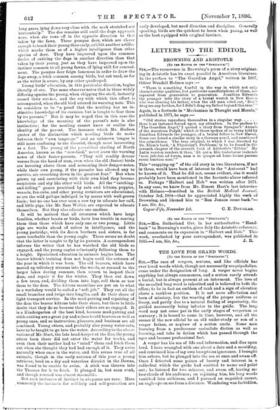ANIMAL KINDERGARTEN.
AWRITER in the Reading Mercury, describing the games played by lambs, says,—" From one point of view animal life is very serious, and if they are to survive in the struggle they can ill afford to waste time in frivolities. Young creatures are all educated on the Kindergarten system, and the games, in which the parents often join, are mainly mimic warfare or pursuit. The antics of lambs when playing the game I am the King of the Castle' are just those which would be performed, though with more dignity, by a ram confronting his antagonist, and confident of his power to hurl him into the abyss." This extension of the Duke of Wellington's observation on public-school games to the sports of animals is not without probability ; for the in- stinct with which most young animals are equipped is as a rule insufficient to ensure their safety, until education both by their parents and playfellows comes to the aid of inherited impulse.
Mr. W. H. Hudson, when living on the pampas of La Plata, recorded some very interesting observations on the education of the young of animals common on the plains. The half-wild lambs of the pampas remain almost " imbecile " for three days. They are not senseless and helpless like blind puppies, but are equipped with certain instincts which do not answer the purpose for which they were apparently intended. The instances which Mr. Hudson gives of the un- satisfactory working of instinct—which in these lambs is properly so called, for it is prior to education and experience —show how their exisi.ence, intended to benefit the young creature, may actually retard education in the animal Kinder- garten. The pampas lamb has three instincts when born. One is to suck, the second to run after anything moving away from it, and the third to run away from anything ad- vancing towards it. It is in the second and third of these impulses that instinct is of disservice to the lamb. "If the mother turns round and approaches it, even from a very short distance, it will turn round and run from her in fear, and will not understand her voice when she bleats to it ; at the same time it will confidently follow a dog, horse, or man moving from it. It is a very common experience to see a lamb start up from sleep and follow the rider, running close to the heels of the horse. This is distressing to a merciful man who can- not shake the little simpleton off ; and if he rides on, no matter how fast, it will keep up with him or keep him in sight for half a mile or more, and never recover its dam.
1 have seen a lamb, about two days old, start up from sleep, and at once make off in pursuit of a puff-ball about as big as a man's head, carried past'ait over the smooth turf by the wind."
The uneducated instinct in the case of these lambs is of disservice in place of service. The " following " impulse, obeyed without discrimination, makes them lose their mothers, and the same want of knowledge makes them shun the very creature whose advance they should most desire. The old sheep is therefore obliged to devote herself during the first week of her Iamb's existence to " unteaching " instinct and substituting sense, which it does mainly by con- vincing the lamb that she, and no other creature, is to be followed. This first lesson once learnt, the rest follows easily. The fawn of the common pampas deer is born equipped with instinct for concealment similar to that which the young plover has on leaving the egg. But it is at once educated by the doe to use this to the best advantage. She teaches it to improve upon the original instinct. "When the doe with a fawn is approached by a horseman with dogs she stands perfectly motionless, gazing fixedly at the enemy, the fawn motionless at her side. Sud- denly, as if by some signal, the fawn rushes away from her at utmost speed ; and going to a distance of from six hundred to one thousand yards conceals itself in a bottom, or among the long grass, lying down very close with the neck stretched out horizontally." The doe remains still until the dogs approach near, when she rune off in the opposite direction to that
taken by the fawn. These pampas deer, which are clever enough to teach their young thus early, exhibit another artifice which marks them as of a higher intelligence than other species of deer. They have improved upon the common device of enticing the dogs in another direction than that taken by their young, just as they have improved upon the instinct common to all young fawns, of lying still for conceal- ment. The pampas deer feign lameness in order to draw the dogs away, a trick common among birds, but not used, so far as the writer is aware, by any other quadruped.
Young birds' education, in this particular direction, begins literally ab elm. The same observer notes that in three widely differing species the young, when chipping the shell, instantly ceased their strokes, and the cry with which this effort is accompanied, when the old bird uttered its warning note. This be considers to be "a proof that the nestling has no in- stinctive knowledge of its enemies, but is taught to fear them by its parents." But it may be urged that in this case the knowledge of the meaning of the parent's note is also instinctive ; for the nestling cannot know or realise the identity of the parent. The instance which Mr. Hudson quotes of the distinction which nestling birds do make between their "own language" and an unknown tongue is still more confusing to the theorist, though most interesting as a fact. The young of the parasitical starling of North America, known as the "cow-bird," never ;earn the warning notes of their foster-parents. "They will readily devour worms from the hand of man, even when the old (foster) birds are hovering above them and screaming their danger-notes, while their own young, if the parasite has allowed any to survive, are crouching down in the greatest fear." But when grown up and associating with their own kind they become suspicious and shy like other wild birds. All the " catching- and-killing " games practised by cats and kittens, puppies, weasels, fox-cubs, and other young carnivora are educational, so are the wild gallops indulged in by mares with well-grown foals ; but no one has ever seen a cow try to educate her calf, and little pigs, like Mr. Sam Weller, are expected to educate themselves. But they also educate one another.
It will be noticed that all creatures which have large families, whether beasts or birds, have less trouble in rearing them than those which have only one or two young. Little pigs are weeks ahead of calves in intelligence, and the young partridge, with its dozen brothers and sisters, is far more teachable than the young eagle. There seems no doubt that the latter is taught to fly by its parents. A correspondent informs the writer that he has watched the old birds so engaged, and the young eagles reluctantly following them to a height. Specialised education in animals begins late. The beaver kitten's training does not begin until the autumn of the year in which it was born. The old beavers, which have moved up tributary streams into the woods, or roamed to the larger lakes during summer, then return to inspect their dam, and repair it for the winter. They then cat down a few trees, and, dividing them into logs, roll them or tow them to the dam. The kittens meantime are put on to what in a workshop would be called a "soft job." They cut all the small branches and twigs into lengths, and do their share of light transport service. In the mud-patting and repairing of the dam the beaver kittens take their share, but there is little doubt that they do so because their elders are so engaged. It is a Kindergarten of the best kind, because mud-patting and stick-cutting are a great joy and solace to old beavers as well as young ones, and so instruction, pleasure, and business are all combined Young otters, and probably also young water-rats, have to be taught to go into the water. According to the obser- vations of Mr. Hart, the late head-keeper at the Zoo, the young otters born there did not enter the water for weeks, and even then their mother had to "mind" them and fetch them out when she thought they had had encugh of it. They swim naturally when once in the water, and this seems true of all animals, though in the early autumn of this year A young retriever, bred on a dry and waterless district in the Downs, was found to be unable to swim. A stick was thrown into the Thames for it to fetch. It plunged in, but soon Intik, and though rescued was almost insensible.
But such instances of instinct in abeyance are rare. More commonly the instincts for self-help and self-protection are early developed, but need direction and discipline. Generally speaking, birds are the quickest to learn when young, as well as the best equipped with original instinct.



















































 Previous page
Previous page